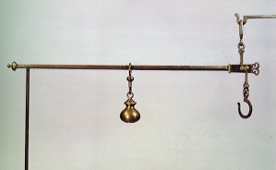
59.6 x 155.7
Steel and brass
INDEX 1788 : C.IV.212
Altera Statera similis, sed minor, qua pondus 620. libr. potest explorari, cum sacomate. Haec pariter cum praedicta Machina in aliquibus experimentis adhibetur.
Another similar balance but smaller and with which a weight of as much as 620 pounds can be evaluated with counterbalance. This one is used in some experiments along with the machine mentioned previously.
This copy of a steelyard measures 1.56 m in length. The longer arm measures 1.45 m and has 60 divisions, these being subdivided into 4 divisions. The divisions are not numbered except for those at the ends: 40 at the end furthest from the fulcrum and 12 at the end nearest to it. The sliding weight is pear shaped and weighs approximately 9 kg, and the hook from which it is suspended carries the mark of the maker: RF LXA. C.PIETRA. According to the Index Instrumentorum this steelyard could hold weight of up to 920 pounds (450 kg).
In his book Physicae Experimentalis et Geometricae, Peter Van Musschenbroek, presents an experimental study in the chapter entitled Introductio ad Cohaerentiam - Corporum Firmorum, where a steelyard with similar characteristics to the one in the Gabinete de Física in Coimbra is used. The way in which Musschenbroek uses it is intended to determine the rupture tension of pieces with different geometry and made of distinct materials. The machine is mounted on a suitable support which offers sufficient mechanical resistance. It is suspended on a horizontal cross-bar with a very thick quadrangular cross section. This cross-bar is supported by two robust vertical columns which stand on a horizontal platform longer than the balance.
The piece whose rupture tension was to be determined was placed between the hook of the steelyard and the platform. The intensity of the force of traction to which the piece is subject varies depending on the position of the sliding weight. To avoid a strong impact between the balance and the platform of the supporting structure when the rupture occurs, there was a rope between the two columns used to hold the steelyard.
In the above-mentioned book, Musschenbroek presents pictures of various fractured pieces which had been the object of study, and details about the fastening of these pieces between the hook and the platform.
From Colégio dos Nobres, catalogue n.º 202.
Musschenbroek, Peter Van, Physicae Experimentalis et Geometricae, Leiden, 1729, p.483, Tab. XIX, fig 6, Tab.XX, Tab. XXI,
Tab. XXII.